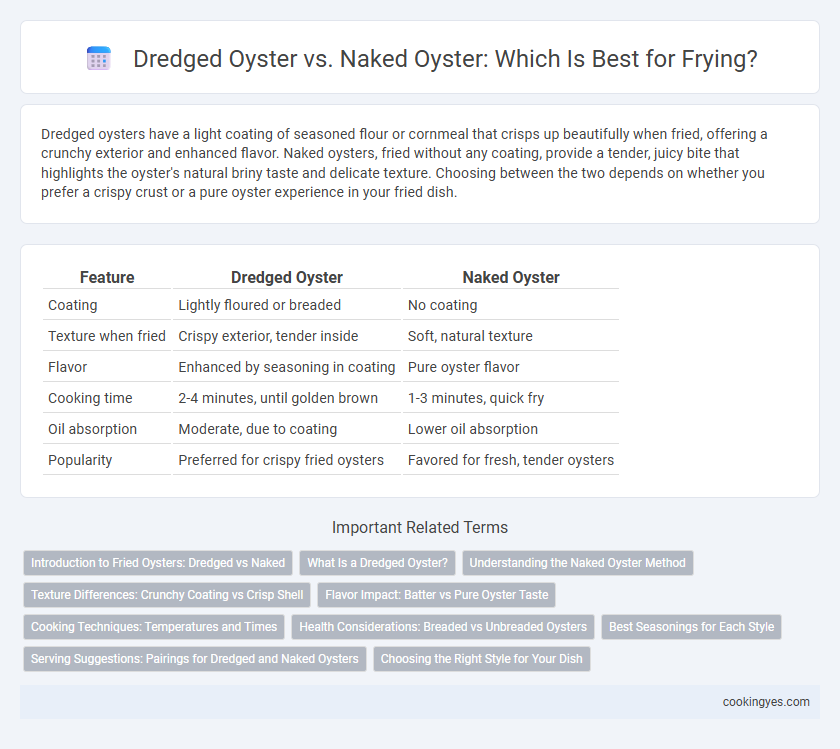Dredged oysters have a light coating of seasoned flour or cornmeal that crisps up beautifully when fried, offering a crunchy exterior and enhanced flavor. Naked oysters, fried without any coating, provide a tender, juicy bite that highlights the oyster's natural briny taste and delicate texture. Choosing between the two depends on whether you prefer a crispy crust or a pure oyster experience in your fried dish.
Table of Comparison
| Feature | Dredged Oyster | Naked Oyster |
|---|---|---|
| Coating | Lightly floured or breaded | No coating |
| Texture when fried | Crispy exterior, tender inside | Soft, natural texture |
| Flavor | Enhanced by seasoning in coating | Pure oyster flavor |
| Cooking time | 2-4 minutes, until golden brown | 1-3 minutes, quick fry |
| Oil absorption | Moderate, due to coating | Lower oil absorption |
| Popularity | Preferred for crispy fried oysters | Favored for fresh, tender oysters |
Introduction to Fried Oysters: Dredged vs Naked
Dredged oysters, coated in seasoned flour or cornmeal, create a crispy, flavorful exterior when fried, enhancing the texture and taste experience. Naked oysters, fried without coating, offer a pure, briny flavor and tender bite that highlights the oyster's natural freshness. Choosing between dredged and naked fried oysters depends on preference for either a crunchy crust or the oyster's authentic, unmasked taste.
What Is a Dredged Oyster?
A dredged oyster is an oyster coated in a seasoned flour or cornmeal mixture before frying, creating a crispy, flavorful exterior that locks in moisture. Unlike a naked oyster, which is fried without any coating, dredged oysters offer a textured bite and enhanced flavor profile that complements their natural brininess. This preparation method is popular in Southern cuisine, emphasizing a balance between crispiness and the oyster's fresh, oceanic taste.
Understanding the Naked Oyster Method
The Naked Oyster method involves frying oysters without the traditional breading or batter, highlighting the oyster's natural briny flavor and tender texture. Unlike dredged oysters, which are coated in flour or cornmeal to create a crispy exterior, naked oysters rely on precise temperature control and minimal seasoning to achieve a delicate, golden sear. This approach enhances the oyster's fresh, oceanic taste and offers a lighter, less greasy alternative favored in modern culinary techniques.
Texture Differences: Crunchy Coating vs Crisp Shell
Dredged oysters feature a crunchy coating created by a seasoned flour or cornmeal mixture that crisps up during frying, providing a textured, flavorful bite. Naked oysters, fried without a coating, retain their natural crisp shell texture, offering a lighter, more delicate crunch that highlights the oyster's inner tenderness. The choice between dredged and naked oysters affects the overall mouthfeel, with dredged oysters delivering a robust crunch and naked oysters emphasizing the shell's subtle crispness.
Flavor Impact: Batter vs Pure Oyster Taste
Dredged oysters coated in a seasoned batter typically deliver a crispy texture and a flavor profile that highlights the spices and breading, often masking the oyster's natural brininess. Naked oysters, fried without batter, preserve the pure, sweet, and briny taste inherent to the oyster, offering a more authentic seafood experience. Choosing between dredged or naked frying depends on whether the priority is a flavorful, crunchy exterior or an unadulterated oyster flavor.
Cooking Techniques: Temperatures and Times
Dredged oysters, coated with flour or cornmeal, require frying at 350-375degF for 2-3 minutes to achieve a crispy exterior while maintaining a juicy interior. Naked oysters, without coating, cook faster at 300-325degF for 1-2 minutes, resulting in a tender, delicate texture. Monitoring oil temperature precisely prevents overcooking and preserves the oysters' natural flavor and moisture.
Health Considerations: Breaded vs Unbreaded Oysters
Breaded oysters, including dredged varieties, contain added calories and fats due to the coating, which can impact heart health compared to unbreaded naked oysters. Naked oysters provide a leaner option rich in omega-3 fatty acids, zinc, and low in cholesterol, promoting cardiovascular benefits. Choosing unbreaded oysters for frying preserves their natural nutrients and minimizes added unhealthy fats, supporting a healthier diet.
Best Seasonings for Each Style
Dredged oysters benefit from bold, savory seasonings like Cajun spice blends, smoked paprika, and garlic powder to complement their crisp, crunchy coating, enhancing their deep-fried texture. Naked oysters, with their tender, delicate flavor, pair best with lighter seasonings such as lemon zest, fresh herbs like parsley or dill, and a touch of sea salt to preserve their natural brininess. Selecting the right seasoning intensifies the unique taste profile of each oyster style, elevating the frying experience.
Serving Suggestions: Pairings for Dredged and Naked Oysters
Dredged oysters, coated in seasoned flour or cornmeal, offer a crispy texture that pairs excellently with tangy cocktail sauce, spicy remoulade, or a squeeze of fresh lemon to enhance their rich flavor. Naked oysters, served raw or lightly steamed, showcase their natural brininess and are best complemented by mignonette sauce, freshly grated horseradish, or a splash of crisp white wine like Sauvignon Blanc. Both types shine when paired with light, refreshing sides such as cucumber salad, pickled vegetables, or a simple green salad to balance the oysters' savory notes.
Choosing the Right Style for Your Dish
Dredged oysters, coated in a seasoned flour or breadcrumb mixture, create a crispy, flavorful crust ideal for frying, offering a satisfying texture contrast to the tender oyster inside. Naked oysters, without any coating, deliver a pure, briny taste that highlights the oyster's natural sweetness and oceanic flavor, perfect for those seeking simplicity and freshness in fried dishes. Choosing dredged oysters enhances crunch and seasoning, while naked oysters provide an authentic, minimalist experience.
Dredged Oyster vs Naked Oyster for frying Infographic

 cookingyes.com
cookingyes.com